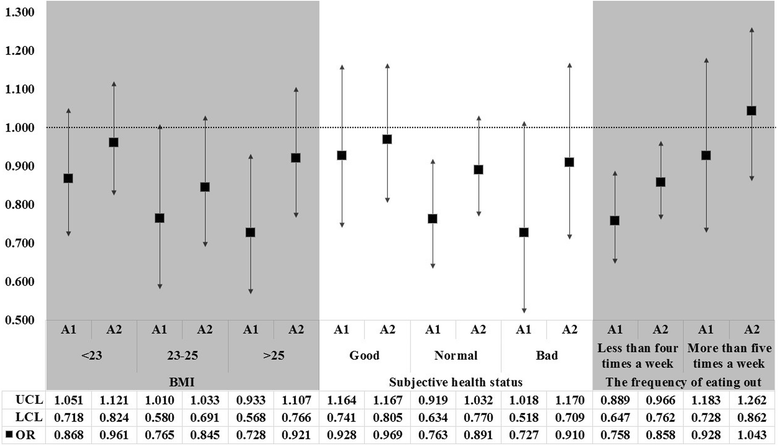Is nutritional labeling associated with individual health? The effects of labeling-based awareness on dyslipidemia risk in a South Korean population
- PMID: 27628312
- PMCID: PMC5024492
- DOI: 10.1186/s12937-016-0200-y
Is nutritional labeling associated with individual health? The effects of labeling-based awareness on dyslipidemia risk in a South Korean population
Abstract
Background: In 1995, the South Korean government made nutrition labeling compulsory, which has positively impacted patients with certain chronic diseases, such as dyslipidemia. We investigated the association between nutrition labeling-based awareness and the risk of dyslipidemia among individuals not yet diagnosed.
Methods: Our study used data from the fifth Korea National Health and Nutrition Examination Surveys administered during 2010-2014 (n = 17,687). We performed multiple or logistic regression analysis to examine the association between nutritional analysis and various outcome variables.
Results: Approximately 70 % of the respondents (n = 11,513) were familiar with nutrition labeling, of which 20 % (n = 3172) decided what food to buy based on that information. This awareness yielded mostly positive results on outcome indicators, such as triglyceride and high-density lipoprotein cholesterol levels. In general, individuals who used nutritional labels to make decisions regarding food purchases had a lower risk of dyslipidemia than individuals who did not (OR: 0.806, 95 % CI: 0.709-0.917).
Conclusion: Utilizing nutrition labels for making food choices correlated with a lower risk of dyslipidemia in certain subgroups. Based on our findings, we recommend that health policymakers and medical professionals consider promoting nutrition labeling as an alternative method for managing certain chronic diseases in South Korean patients.
Keywords: Dyslipidemia; Health policy perception; Hyperlipidemia; Nutrition labeling.
Figures


References
-
- Thankappan K, Shah B, Mathur P, Sarma P, Srinivas G, Mini G, Daivadanam M, Soman B, Vasan RS. Risk factor profile for chronic non-communicable diseases: results of a community-based study in Kerala, India. Indian J Med Res. 2010;131(1):53. - PubMed
-
- Zimmet P, King H, Björntorp S. Obesity, hypertension, carbohydrate disorders and the risk of chronic diseases. Is there any epidemiological evidence for integrated prevention programmes? Med J Aust. 1986;145(6):256–9. - PubMed
-
- Genest J, McPherson R, Frohlich J, Anderson T, Campbell N, Carpentier A, Couture P, Dufour R, Fodor G, Francis GA. 2009 Canadian Cardiovascular Society/Canadian guidelines for the diagnosis and treatment of dyslipidemia and prevention of cardiovascular disease in the adult–2009 recommendations. Can J Cardiol. 2009;25(10):567–79. doi: 10.1016/S0828-282X(09)70715-9. - DOI - PMC - PubMed
MeSH terms
Substances
LinkOut - more resources
Full Text Sources
Other Literature Sources
Medical

